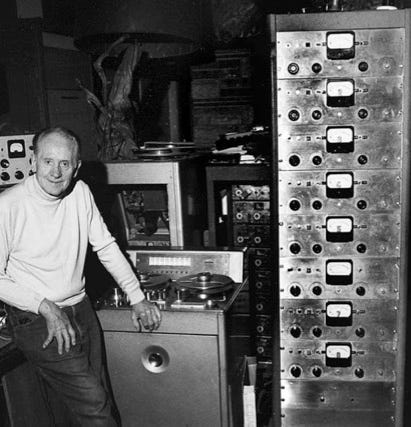Les Paul Remembers, Episode 2: "I don't know where to put the damn thing."
"That's it right there," Les said, pointing to the world's first eight-track recording machine, parked outside the kitchen.
Like the Volkswagen, the tape recorder has less than savory origins: both are products of Hitler’s Germany. The world’s first tape deck, the Magnetophon K-1, was built in 1935, two years after Hitler’s rise to power. It was not until the final months of World War II that victorious Allied troops—specifically, Lieut. Jack Mullin of the U.S. Army Signal Corps, a brilliant inventor and engineer—came across a Magnetophon and flipped—the machine’s audio quality was so high that one might have been listening to live music. Mullin brought the Magnetophon back to the states, where, long story short, his friend Les Paul used it as a stepping-stone towards what Paul considered his greatest invention, the multitrack tape recorder.
“That’s it right there,” he said when I visited him in 1984, pointing at a dial-studded gizmo that looked like a prop from a Fifties science-fiction movie, parked just outside of Paul’s kitchen: the world’s first eight-track tape recorder, which the Ampex Corporation built to Les’s specifications and installed in his Mahwah, New Jersey home in 1957. It was covered with a thick coat of dust. “I don’t know where to put the damn thing,” said Les.
The world’s first eight-track recording machine, taking up space in Les’s living room.
The damn thing, of course, stood the recording industry on its head. A bit of backstory: Les’s first step, in the Forties, towards layering multiple taped performances—guitar, bass, piano, the great Mary Ford’s vocals—on top of each other had been just that: an audio layer cake. Les laid down an initial performance, usually on rhythm guitar, and—this is key—deactivated the recording machine’s erase head, so that what you got, bit by bit, was an increasingly rich, dense piece of music, but on a single track, each performance layered on top of the previously recorded one, which remained. Because this was all being blended together on a single, indivisible track, if the guitarist, or the singer, made a boo-boo on their twelfth pass, they had to start all over again, with the initial, bottom performance. What a nuisance!
Les’s tremendous achievement was to build a machine on which he could record multiple, entirely separate tracks, not successive, layered performances. If he played a bum guitar lick on his seventh pass, all he had to do was re-record that one track, not all 15 or 20. The recording industry would never be the same. So it’s not surprising that Les considered the multitrack tape machine his signal achievement, more special, even, than the vaunted Gibson Les Paul guitar.
Much more than the above unfolds in this episode’s deceptively brief interview chunk. How, for instance, Les discovered and honed his jazz chops in Thirties Chicago, playing country-music radio by day, stage name “Rhubarb Red,” and jamming at night with, literally, some of the music’s all-time greats, including Jack Teagarden, Dave Tough, Coleman Hawkins, Earl Hines, Pops Armstrong himself. And how “1960 was your slamming of the door, rock & roll putting Les and his contemporaries out of business. “Sinatra weathered the storm,” Les recalled. “But if you look at Peggy Lee, Bing Crosby, Benny Goodman, Count Basie, every one of them was pushed to the side. It was almost impossible to make a rock star out of Mary, so she just threw in the towel. I kept going, but I did it more in inventing and less in music.”
Coming up in Episode 3: “New York in the Forties were the best years of my life. Hands down. Every jazz musician in New York seemed to live in Jackson Heights, Queens. Eighty-first and Roosevelt, that’s where I built the illegal radio station. Every great player, and some not so great—they all lived in Jackson Heights. Now, if you ever ran into a nicer place in your lifetime, I’d like to know where in the hell it’s gonna be.”
“I invent because I lie down in bed and it all of a sudden it dawns on me, ‘My God, here’s the answer to the problem that’s been buggin’ me. And my goodness, it’s this simple. And I go build one, and it works!”




